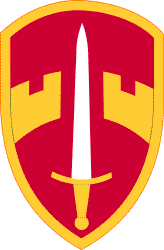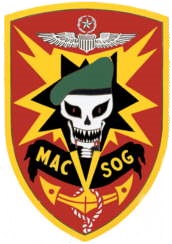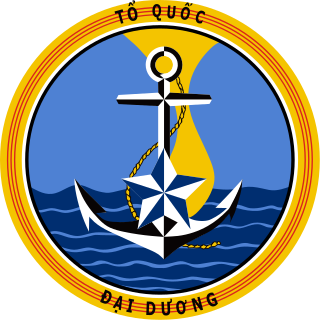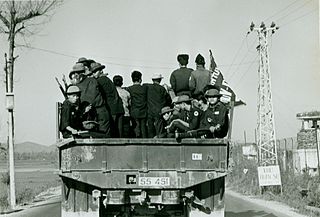Upon the departure of the French in 1955, the U.S. became directly involved with the Vietnamese government in the south partition and MAAG, Vietnam (MAAGV) was established. [6] [7] Restrictions set down in the Geneva Agreements limited the number of military personnel that could be in South Vietnam at any one time. From 1955 to 1959 there were never more than 79 naval advisors in country. The Navy Section MAAG advisors were responsible for training the Republic of Vietnam Navy (RVNN) and Marine Corps and providing material assistance. Additionally, they evaluated new weapons, boats, and equipment that were being developed for use by the RVNN. [8]
In 1959, North Vietnam began a long-term campaign to overthrow the South Vietnamese government through political subversion and armed conflict. As the actions of the North Vietnamese-backed Viet Cong intensified, MAAG, Vietnam was called upon to provide even more training assistance to the South Vietnamese armed forces. The Navy Section of MAAGV increased their strength from 79 to 164 by 1964. [9] Navy Section MAAGV advisors began accompanying the RVNN's River Assault Groups on combat missions in the field during this period. Additionally, a small group of Navy Section MAAGV personnel served on the newly formed Military Assistance Command Vietnam (MACV) after it was formed on 8 February 1962. MAAGV and its Naval Section was disestablished and absorbed by MACV on 15 May 1964. The Naval Advisory Group (NAG) of MACV assumed the responsibilities of the old Naval Section. At the end of 1964 there were 235 sailors assigned to MACV duties which included support functions in the Saigon area, construction and medical activities, and advising the South Vietnamese Navy and the marine corps. [9]
Establishment
The vast, continuing increase in U.S. and allied military forces in South Vietnam in 1965 and 1966 brought with it a corresponding increase in United States Navy forces. The first operational U.S. Navy units began operations on 24 March 1965 with the establishment of the Vietnam Patrol Force (Commander, Task Force 71), which was under the operational control of the Seventh Fleet and was the American component of Operation Market Time. On 30 July, Task Force 71 was deactivated and operational control was shifted to Commander, Task Force 115, which was part of the Naval Advisory Group of MACV in Saigon. Market Time continued, with the addition of U.S. Navy surveillance aircraft, high speed PCF (Swift) coastal patrol boats, and U.S. Coast Guard Point-class cutters. [10]
Late 1965 saw planning for the second major influx of operational U.S. Navy units. Operation Game Warden, designed to supplement RVNN units in patrol of the Mekong Delta and Rung Sat Special Zone waterways, was to come into operation on 18 December 1966 and designated as Task Force 116. High-speed River Patrol Boats (PBRs) were assigned as the principal patrol vessels. [11]
With these operations came the requirement for the construction of new facilities. Navy Civil Engineer Corps personnel, assigned to the Officer in Charge of Construction, Vietnam, were designated to supervise the bulk of military construction, although the majority of the work was being performed by civilian contractors. Included in this construction were new Market Time and Game Warden bases. [12] : 1–2
Headquarters Support Activity, Saigon was destined to transfer its functions to the Army by May 1966, but some of its personnel and facilities were to be incorporated into Naval Support Activity Saigon to provide logistic support for U.S. Navy activities in the II, III and IV Corps Tactical Zones. Naval Support Activity Danang (NSA Danang), activated in 1965 for support of Marine and Navy operations in the I Corps Tactical Zone (I CTZ), was to be expanded to support all U.S. and allied forces in I CTZ. [12] : 2
Also under construction were harbor facilities to support the military buildup. U.S. Navy Harbor Defense and Harbor Clearance units were to be assigned to these areas. In addition, mine countermeasures forces were to be employed, both on the main ship channels to Saigon and in the harbor and coastal areas. The possibility of a U.S. River Assault Group (RAG) was under consideration to supplement the South Vietnamese navy's RAGs in operations in the Mekong Delta and the Rung Sat Special Zone. [13] [12] : 2
With the continually increasing United States Navy commitments in Vietnam, early 1966 brought the requirement for better integration of all U.S. Navy activities assigned to MACV. Three months of planning culminated in the establishment of U.S. Naval Forces, Vietnam on 1 April. In early January the requirements for a Naval Component Commander were forwarded to COMUSMACV. [14] At this time, the Commanding General III Marine Amphibious Force (III MAF), with headquarters in Da Nang, was performing the task of Naval Component Commander for MACV; and Commander U.S. Naval Forces Philippines was the navy area coordination authority. Commanding General III MAF's many functions encompassed the direction of the bulk of the war effort in the I Corps Tactical Zone in addition to discharging the Naval Component Commander functions in South Vietnam (with the exception) of those functions performed by Chief, Naval Advisory Group (CHNAVADVGRP). His many duties in the I CTZ resulted in the NCC being unable to adequately supervise many NCC functions in the II, III and IV Corps Tactical Zones. In addition, the presence of the Commanding General, III MAF was almost continually required in the I CTZ, a 340 miles (550 km) separation from COMUSMACV Headquarters in Saigon. This prohibited frequent personal contact between COMUSMACV and his Naval Component Commander. [12] : 2–3
With the increase in U.S. naval forces, there also existed the need for a more responsive organization to provide for the supervision of uni-service Navy matters. Again, geography prevented effective supervision by Commanding General, III MAF, and to an even greater extent prevented effective participation by Commander U.S. Naval Forces, Philippines. Chief, Naval Advisory Group was unavoidably involved in naval matters not necessarily related to NAVADVGRP functions. As CHNAVADVGRP, he was a member of COMUSMACV staff, as such not in command of a naval organization, but tasked to advise COMUSMACV on naval matters. In addition, he was CTF 115 and CTF 116. Yet, involved as he was, he had not fully appropriate channels to the Naval Component Commander, the Fleet Commander nor the Pacific Fleet type commanders. [12] : 3–4
With the continuing growth of the Navy establishment in Vietnam and the problems of a Naval Component Commander remote from the center of naval operations, the need existed for a change in the Naval Component Commander structure to provide an organization more responsive to the needs of COMUSMACV and the Navy. It was proposed that a major Navy command with a flag officer be established in Saigon under the command of the United States Pacific Fleet and under the operational control of COMUSMACV. This command would exercise operational control under COMUSMACV of the Coastal Surveillance Force, the River Patrol Force and other Navy units as specifically assigned. In addition, the command would serve as the Navy area coordinator for South Vietnam. [12] : 4
On 13 January COMUSMACV proposed to CINCPAC the formation of just such a major Navy command, and that it be titled U.S. Naval Forces, U.S. Military Assistance Command, Vietnam (NAVFORV). Under this proposal, COMNAVFORV would have the additional duty of CHNAVADVGRP because of the prestige and possible political gain to the RVNN and Marine Corps. In addition, COMUSMACV proposed: that III MAF be designated as a separate uni-service command within MACV; that a flag officer junior to COMNAVFORV be Commander NSA Danang; and that COMNAVFORV through NSA Danang would provide logistic support to all U.S. Forces in the I CTZ; that Navy captains be ordered to command of Task Force 115 and Task Force 116; and that NAVFORV be established at the earliest possible date. [12] : 4–5
In late January the proposal was forwarded to the Joint Chiefs of Staff for approval. Approval was granted on 14 February, and mere definite requirements were worked out. Estimates of personnel requirements were prepared and forwarded to CINCPACFLT on 13 February. On 14 March CINCPACFLT forwarded the proposed tasks for COMNAVFORV, and recommended that the transfer of Naval Component Commander functions and the activation of NAVFORV be effected on 1 April. [12] : 5
On 1 April, in ceremonies aboard USS Lowe in Saigon Harbor, Rear Admiral Norvell G. Ward established and assumed command of NAVFORV. He retained the posts of CTF 115, CTF 116 and CHMAVADVGKP. On 16 April Admiral Ward was relieved as CTF 115 by Captain Clifford L. Stewart. On 21 April CINCPACFLT defined the terms of reference for COMNAVFORV as an in-service commander. [12] : 5





















